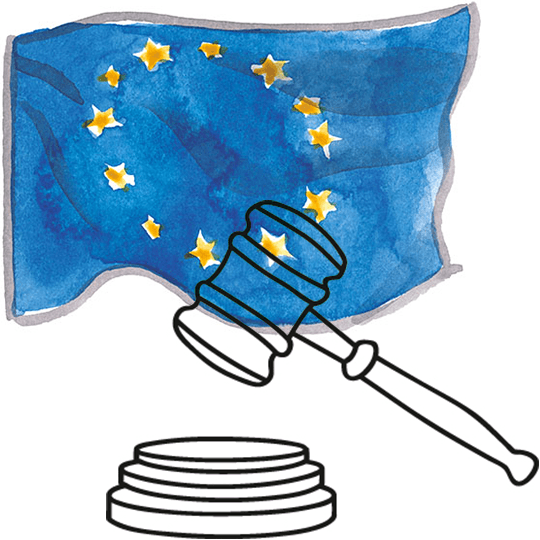 We are finally reaching the end of 2020. It has been a year of turbulence and upheaval in every area of the economy including the financial sector, but there have been bright spots too. For the green bond market, the finalisation of the first criteria for the new EU Taxonomy and EU Green Bond Standard is a milestone. This will have a long-term positive impact on the integrity and transparency of the EU Green Bond market, and is expected to act as the blueprint for regulation in other regions. In this bulletin, we take a deeper dive into what this Taxonomy looks like and what it means for green bond investors. We’ve created a download alignment exercise with the EU Taxonomy, using a bond from our portfolio to clarify how this landmark piece of legislation will work in practice.
We are finally reaching the end of 2020. It has been a year of turbulence and upheaval in every area of the economy including the financial sector, but there have been bright spots too. For the green bond market, the finalisation of the first criteria for the new EU Taxonomy and EU Green Bond Standard is a milestone. This will have a long-term positive impact on the integrity and transparency of the EU Green Bond market, and is expected to act as the blueprint for regulation in other regions. In this bulletin, we take a deeper dive into what this Taxonomy looks like and what it means for green bond investors. We’ve created a download alignment exercise with the EU Taxonomy, using a bond from our portfolio to clarify how this landmark piece of legislation will work in practice.
What are the EU Taxonomy and Green Bond Standard and why were they created?
Both the EU Taxonomy and the EU Green Bond Standard are pieces of legislation that stem from the EU’s Sustainable Action Plan to finance sustainable economic growth in Europe. The EU Taxonomy covers a range of economic activities that account for 93.2% of greenhouse gas emissions in today’s world. It includes a set of criteria for each activity which must be met in order for them to be categorized as sustainable/green.
The EU Taxonomy Regulation sets out six environmental objectives and sets performance thresholds (technical screening data) for economic activities. An activity will be considered compliant with the EU Taxonomy if it contributes substantially to one or more of the environmental objectives or enables other activities to make a substantial contribution to one or more of them; does no significant harm to other environmental objectives (DNSH); and complies with social and governance safeguards.
Figure 1: EU Taxonomy’s six environmental objectives

Source: EU Technical Expert Group on Sustainable Finance[1]
The EU Green Bond Standard is a four-part standard. Firstly, it requires the economic activity/activities that a bond finances to be aligned with the EU Taxonomy. The bond issuer should then follow the normal procedures prescribed by the International Capital Market Association’s Green Bond Principles. These consist of providing a green bond framework that shows how the proceeds will be used and managed, providing annual impact and allocation reporting, and obtaining a third-party verification.
These last three parts will already be familiar to green bond issuers, but the taxonomy alignment is new, and it may take some time for people to get up to speed with it. If an issuer in, or operating in, the EU has a company of over 500 employees and wants to issue a green bond, they will need to refer to these new criteria to make sure the activities the bond finances are actually green. Prior to the EU Taxonomy, there was some global guidance in the Climate Bonds Initiative (CBI) taxonomy, and some loose categories of activities provided by the Green Bond Principles, but no EU-wide definition as to what constitutes a green activity across different sectors. This new uniform definition reduces the likelihood of greenwashing and will help streamline green investment in general. For example, a green bond investing in renewable energy would meet the Green Bond Principles, but under the EU Taxonomy, it would also need to meet specific criteria associated with the type of renewable energy being financed. Only then can it be deemed an eligible green activity.
What are the implications for asset managers and issuers?
Asset managers will have to show their alignment with the EU Taxonomy in their portfolios by 1 January 2022; for issuers, the deadline is the end of 2022. In both cases, this alignment information should also be made public. As yet, there is no specified required alignment percentage. In terms of its scope, the EU Taxonomy will impact a broad range of funds that fall under classifications of Article 9 (has a sustainable objective) and Article 8 (promotes ESG characteristics) in particular.[2] The implications will look different for each fund and product. In this bulletin, we focus on the impact for a green bond fund.
The implications for issuers and investors depend to a large extent on how advanced their data collection process already is. If investors have been regularly evaluating individual economic activities and following the CBI Taxonomy and the draft EU Taxonomy criteria, the alignment exercise need not have a great impact on their portfolios. If, however, a fund has simply been investing in green bonds based on the green label without recording detailed information about the activities linked to each bond, then this alignment exercise could be quite a mammoth task.
At NN IP our analysts and portfolio managers already carry out their own thorough evaluation of both the projects the bond finances and the company itself by assessing both quantitative and qualitative indicators. We never rely on a bond’s green label and external data alone. We already have a tried and tested evaluation process in place and the new taxonomy criteria provide a great addition to our already comprehensive technical specifications for the industry.
Who has to comply?
Financial market participants and large companies that fulfil certain criteria[3] will have to comply with the EU Taxonomy. They will also be required to publish a non-financial statement under the Accounting Directive, as amended by the Non-Financial Reporting Directive. The NFRD includes more stringent and standardized requirements for how companies report non-financial information and how they disclose ESG data.
Figure 2: Three groups of taxonomy users

Source: EU Technical Expert Group on Sustainable Finance[4]
The alignment exercise – how does it work, is it complicated and what do we expect from issuers?
Yes, it is quite complicated and it will take investors some time to align their whole portfolios. Initially, we can perform the alignment exercise ourselves, as not all issuers are able to provide us with all the required data. We are in a better position than many other green bond funds because we have already been recording a high level of individual activity data from each bond for years, so we are starting off with an advantage. We will officially begin our alignment process in January 2021 to ensure that we are ready to provide the necessary documentation by the deadline of 1 January 2022.
Figure 3: EU Green Bond Standard

Timelines are aligned with EU Taxonomy implementation Source: NN Investment Partners
Alignment exercise in a nutshell
Step 1: We take a green bond and look at which activities are financed by this bond.
Step 2: We examine the mitigation criteria of each activity within the bond and check to see if they pass. If they do, they are officially contributing to the climate mitigation environmental objective. If one of the activities in the bond does not pass, this reduces the percentage of alignment.
Step 3: Do No Significant Harm. Within each economic activity, there are areas of DNSH which are identified as risk areas for that sector. We check whether steps have been taken to assess the risks which the project could pose for each activity the bond finances and whether actions and infrastructure have been put in place to minimize these risks. If so, the economic activity passes the do no significant harm criterion as the project is not harming any other environmental objectives.
Step 4: We repeat this for all activities in the bond to obtain a percentage alignment for the whole bond.
Step 5: As part of our assessment, we ensure the issuer is adhering to minimum social safeguards on a project level as well as issuer level. Most issuers make the high-level information easily available, such as whether or not they are a signatory to the UN Global Compact.
Step 6: We finally calculate the weighting of the bond within the portfolio and use this figure to calculate the percentage alignment with the EU Taxonomy which this bond brings to the portfolio.
While it is true that investors must provide their EU Taxonomy alignment before issuers in the EU Taxonomy timeline, we are happy to see some – albeit a minority – already including taxonomy-alignment information in their green bond frameworks. As use of the EU Taxonomy becomes more widespread, we expect issuers to step up and calculate their alignment with the taxonomy themselves. This would give us all the information we need in a standardized form to incorporate in our own selection process before making a decision on whether to participate in a bond.[5] In our engagement over the past year with issuers we have often highlighted this topic.
Looking ahead
There are likely to be some teething problems as the EU Taxonomy is rolled out in the course of the next couple of years. For example, some investors have started to do alignment exercises for their portfolios, but have been forced to overlook large sections because issuers cannot provide sufficient data. This is a potential problem and may lead to some investors publishing exercises that greatly overexaggerate EU Taxonomy alignment. When done properly, alignment will most likely be low at the beginning, as the market shifts and issuers adjust the level of information they provide. Over the course of time, this should pick up quickly as more financial market participants join in, increasing and improving the level of data available in the green bond sector. As far as NN IP is concerned, at a certain point in time, particularly after the issuer alignment exercise deadline, it will no longer be acceptable for issuers based or operating in the EU not to provide enough data to show alignment with the EU Taxonomy.
The launch of the EU Taxonomy should not fundamentally change the philosophy and investment process for green bond funds. Managers will still be able to follow their own green bond frameworks whether these have stricter or more lenient thresholds than the EU Taxonomy, but the taxonomy will cause a culture change in the industry. It provides clearer definitions of sustainable and green activities for a broader range of economic activities with relevant criteria, creating an unambiguous and harmonized baseline for market participants. This will lead to more self-regulation within the industry as green bond investors and issuers start to be measured against this higher standard.
Once there are official green definitions, any deviations from these will need to be clearly justified. Until now, the increasing number of green bond taxonomies has not altered the fact that green bonds are self-labeled fixed income instruments and that the greenness of the projects they finance is subjectively evaluated by issuers and investors alike. There may be best market practice guidelines but applying these is still voluntary. It remains to be seen whether this new Europe-wide move to more effectively categorize green investments will dampen this more subjective approach and whether these more stringent parameters will curb the trend towards new sustainable product types like sustainability-linked and transition bonds.
In terms of the longer-term impact, we are confident that the EU Taxonomy and Green Bond Standard will have a positive impact on the green bond market by helping further standardize and professionalize this rapidly maturing fixed income segment. It will help raise knowledge levels on whether economic activities are environmentally friendly and how they can transition to become more sustainable. This will give investors an increasingly transparent and detailed idea of what they are investing in, enabling them to make more well-informed choices, based on more than just financial parameters. It will also raise the bar for issuers. These new regulations herald what could be a watershed decade for climate change mitigation, with Europe leading the way with its target to be carbon neutral by 2050.
Jovita Razauskaite (Portfolio Manager Green Bond) and Isobel Edwards (Investment Analyst Green Bonds) of NN Investment Partners (NN IP)
Click here to download an example of a bond alignment exercise using a bond issued by Austrian electricity company Verbund AG[6], which we hold in our portfolio. [1] https://ec.europa.eu/info/sites/info/files/business_economy_euro/banking_and_finance/documents/200309-sustainable-finance-teg-final-report-taxonomy_en.pdf (page 2) [2] https://ec.europa.eu/info/sites/info/files/business_economy_euro/banking_and_finance/documents/200309-sustainable-finance-teg-final-report-taxonomy_en.pdf (page 39) [3] https://ec.europa.eu/info/sites/info/files/business_economy_euro/banking_and_finance/documents/200309-sustainable-finance-teg-final-report-taxonomy_en.pdf – (page 27) [4] https://ec.europa.eu/info/sites/info/files/business_economy_euro/banking_and_finance/documents/200309-sustainable-finance-teg-final-report-taxonomy_en.pdf – (page 26) [5] See pages 44-50 for a reporting template https://ec.europa.eu/info/sites/info/files/business_economy_euro/banking_and_finance/documents/200309-sustainable-finance-teg-green-bond-standard-usability-guide_en.pdf [6] For illustration purposes only. Company name, explanation and arguments are given as an example and do not represent any recommendation to buy, hold or sell the stock. The security may be/have been removed from portfolio at any time without any pre-notice.






